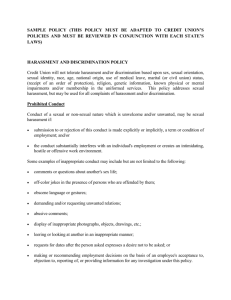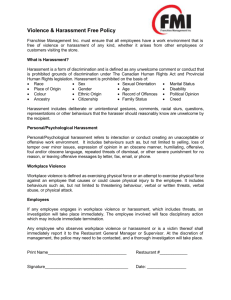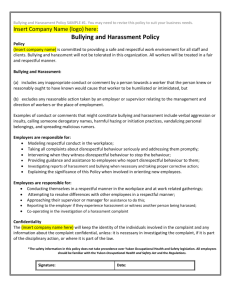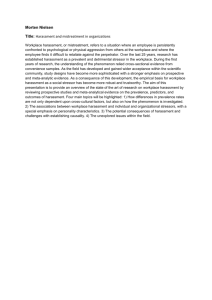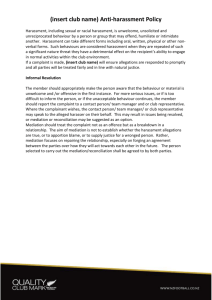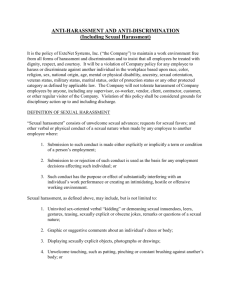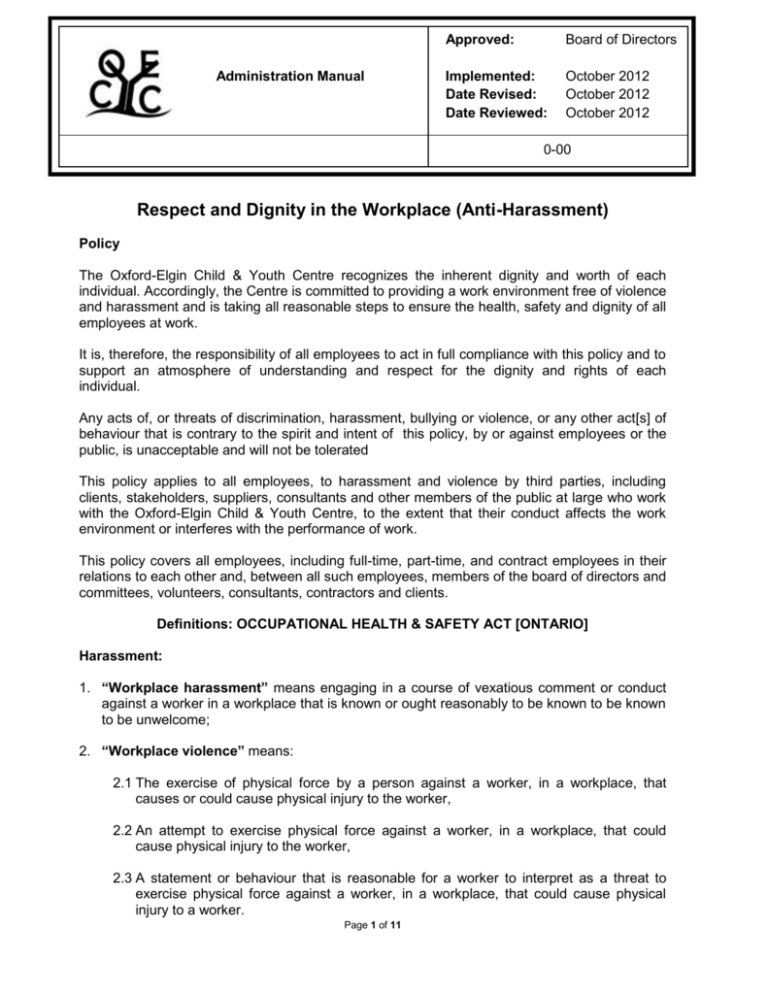
Administration Manual
Approved:
Board of Directors
Implemented:
Date Revised:
Date Reviewed:
October 2012
October 2012
October 2012
0-00
Respect and Dignity in the Workplace (Anti-Harassment)
Policy
The Oxford-Elgin Child & Youth Centre recognizes the inherent dignity and worth of each
individual. Accordingly, the Centre is committed to providing a work environment free of violence
and harassment and is taking all reasonable steps to ensure the health, safety and dignity of all
employees at work.
It is, therefore, the responsibility of all employees to act in full compliance with this policy and to
support an atmosphere of understanding and respect for the dignity and rights of each
individual.
Any acts of, or threats of discrimination, harassment, bullying or violence, or any other act[s] of
behaviour that is contrary to the spirit and intent of this policy, by or against employees or the
public, is unacceptable and will not be tolerated
This policy applies to all employees, to harassment and violence by third parties, including
clients, stakeholders, suppliers, consultants and other members of the public at large who work
with the Oxford-Elgin Child & Youth Centre, to the extent that their conduct affects the work
environment or interferes with the performance of work.
This policy covers all employees, including full-time, part-time, and contract employees in their
relations to each other and, between all such employees, members of the board of directors and
committees, volunteers, consultants, contractors and clients.
Definitions: OCCUPATIONAL HEALTH & SAFETY ACT [ONTARIO]
Harassment:
1. “Workplace harassment” means engaging in a course of vexatious comment or conduct
against a worker in a workplace that is known or ought reasonably to be known to be known
to be unwelcome;
2. “Workplace violence” means:
2.1 The exercise of physical force by a person against a worker, in a workplace, that
causes or could cause physical injury to the worker,
2.2 An attempt to exercise physical force against a worker, in a workplace, that could
cause physical injury to the worker,
2.3 A statement or behaviour that is reasonable for a worker to interpret as a threat to
exercise physical force against a worker, in a workplace, that could cause physical
injury to a worker.
Page 1 of 11
Test of Harassment
It does not matter whether the harasser intended to offend the recipient. The test is whether the
individual engaged in a course of vexatious [to tease, annoy, irritate, aggravate] conduct or
comment that is known, or ought reasonably to be known, to be unwelcome
Discrimination
Workplace discrimination includes any distinction, exclusion or preference based on the
protected grounds in the Ontario Human Rights Code, which eliminates or impairs opportunity in
employment or equality in the terms and conditions of employment.
The protected grounds of discrimination are:
1. Race
2. Colour
3. Ancestry
4. Citizenship
5. Ethnic origin or place of origin
6. Creed, religion
7. Age
8. Sex (including pregnancy)
9. Sexual orientation, gender identity, gender expression
10. Family, marital or same-sex partnership status
11. Disability or perceived disability
A record of offences for which a pardon has been granted under the Criminal Records Act
[Canada] and has not been revoked, or an offence in respect of any provincial enactment.
Definitions
1. SEXUAL HARASSMENT:
Sexual harassment includes conduct or comments of a sexual nature that the recipient does not
welcome or that offended him/her. It also includes negative or inappropriate conduct or
comments that are not necessarily sexual in nature but which are directed at an individual
because of his/her gender. Both men and women can be victims of sexual harassment and of
someone of the same or opposite sex can harass someone else.
Some examples of sexual harassment are:
1. Sexual advances or demands that the recipient does not welcome or want.
2. Threats, punishment or denial of a benefit for refusing a sexual advance.
3. Offering a benefit in exchange for a sexual favour.
4. Leering.
5. Displaying sexually offensive material such as posters, pictures, calendars, cartoons,
screen savers, pornographic or erotic web sites or other electronic material.
6. Distributing sexually explicit e-mail messages or attachments such as pictures or video files.
7. Sexually suggestive or obscene comments or gestures.
8. Unwelcome remarks, jokes, innuendoes, propositions or taunting about a person’s body,
clothing or sex.
9. Persistent, unwanted attention after a consensual relationship ends.
10. Physical contact of a sexual nature such as touching or caressing, and sexual assault.
2. DISCRIMINATORY HARASSMENT:
Discriminatory harassment includes comments or conduct based on the protected grounds in
the Ontario Human Rights Code, which the recipient does not welcome or that offends him/her.
Some examples of discriminatory harassment are:
1. Offensive comments, jokes or behaviour that disparage or ridicule a person’s membership in
one of the protected grounds, such as race, religion or sexual orientation.
2. Imitating a person’s accent, speech or mannerisms.
3. Persistent or inappropriate questions about whether a person is pregnant, has children or
plans to have children; or
4. Inappropriate comments or jokes about an individual’s age, sexual orientation, personal
appearance, or
5. Weight [whether someone is over or underweight.
3. PSYCHOLOGICAL HARASSMENT AND VIOLENCE:
Psychological harassment is bullying or humiliating behaviour that has the following component:
1. It is, generally, repetitive although a single serious incidence of such behaviour may constitute
psychological harassment if it undermines the recipient’s psychological or physical integrity
and has a lasting harmful effect.
2. It is hostile, abusive or inappropriate.
3. It affects the person’s dignity or psychological integrity, and
4. It results in a poisoned work environment.
5. Psychological harassment must not be confused with legitimate management action, including
measures to correct performance deficiencies or to imposing discipline for workplace
infractions.
Some examples of psychological harassment are:
Verbal, abusive behaviour such as yelling, insults and name calling;
Persistent, excessive and unjustified criticism and constant scrutiny;
Spreading malicious rumours;
Excluding or ignoring someone;
Undermining someone else’s efforts by setting impossible goals and deadline;
Sabotaging someone else’s work;
Impeding an individual’s efforts at promotions or transfers;
Making false allegations about someone in memos or other work related document.
6. Violence includes any acts of aggression, physical assault or threats. Some examples of
workplace violence are:
The attempt or exercise of physical force by a person, against another, that causes or
could cause physical injury;
A statement or behaviour that is reasonable for an individual to interpret as a threat to
exercise physical force that could cause physical injury;
Aggressive behaviour such as pushing, shoving, hitting, biting, finger pointing, throwing,
yelling or standing close to someone in an aggressive manner;
Using or threatening to use a weapon.
pg. 4 of 11
4. POISONED WORK ENVIRONMENT:
Even if no one is being, directly targeted, harassing comments or conduct can poison the work
environment, making it a hostile or uncomfortable place in which to work. This is also a form of
harassment.
Some examples of actions that can create a poisoned work environment include:
Displaying offensive or sexual materials such as posters, pictures, calendars, web sites or screen
savers
1. Distributing offensive e-mail messages or attachments such as pictures or video files.
2. Practical jokes that embarrass or insult someone; or
3. Jokes or insults that are offensive.
4. Although it is commonly the case, the harasser does not necessarily have to have the power
or authority over the victim.
5. THE WORKPLACE:
“Workplace” applies to any location in which you are engaged in work-related activities. This
includes, but is not limited to:
1. The workplace
2. During travel
3. At restaurants, hotels or meeting facilities that are being used for business purposes
4. In vehicles
5. Company owned or leased facilities
6. During telephone, email or other communications; and
7. At any social function or event, whether or not it is company sponsored
pg. 5 of 11
PREVENTING HARASSMENT AND VIOLENCE:
It is our mutual responsibility to ensure that we create and maintain a workplace free of
discrimination, harassment and violence.
The Oxford-Elgin Child & Youth Centre will do its part by not tolerating or condoning
discrimination, harassment or violence. This includes making everyone in the organization aware
of what is and what is not appropriate, investigating complaints and imposing suitable corrective
measures.
Managers and supervisors are expected to assist in creating a harassment-free workplace and to
immediately report to the Executive Director if they receive a complaint of workplace harassment,
violence, or if they witness harassing or violent behaviour.
You must do your part by ensuring that your behaviour does not violate this policy and by
fostering a work environment that is based on respect and dignity and is free of harassment.
MANAGEMENT/SUPERVISOR RESPONSIBILITIES:
Managers and supervisors have specific responsibilities to create and maintain a workplace which
is free from harassment and violence. They are responsible for ensuring that harassment is not
allowed, condoned or ignored, and may be considered part to the harassment if they fail to take
the necessary, corrective action.
With a fundamental knowledge and understanding of the policy and guidelines, managers and
supervisors can be the first place for employees to turn to for assistance when trying to deal with
harassment-related concerns. They are also responsible for preventing the development,
escalation or recurrence of harassment.
TO WHOM YOU CAN GO FOR ASSISTANCE OR INFORMATION:
Anyone needing information about this policy or how this policy applies or for clarification of the
policy or, simply, needs to discuss a concern or issue regarding harassment or an incident or to
request action to be taken, may seek assistance from the following:
1. Your immediate Supervisor/Manager, or
2. The Director of Finance and Human Resources, or
3. Clinical Director.
If you are not comfortable to approach any of the above individuals to discuss or consider
pursuing a harassment complaint, you may contact the Executive Director, for confidential
assistance.
The Oxford-Elgin Child & Youth Centre is responsible for promoting, advancing, supporting and
ensuring the effective implementation of this policy
CONFIDENTIALITY:
The agency, through its staff, Management, the Executive Director and its Board of Directors
must ensure that complaints are investigated and handled in such a manner so that the identities
of the persons involved are kept confidential.
It must be recognized, however, that to the extent that the employee chooses to initiate
proceedings or make comments outside the organization’s internal harassment complaint
procedures, confidentiality cannot always be guaranteed.
pg. 6 of 11
It must be recognized, furthermore, that information collected and retained is subject to release
under the Ontario Human Rights Code and the rules governing court procedures.
COMPLAINT HANDLING PROCESS:
The successful resolution of concerns and complaints is oftentimes determined by the way in
which they are handled. The existence of a process with detailed procedures and guidelines is
critical to ensure that all complaints are dealt with in a consistent and fair manner which allows
flexibility to accommodate different situations, circumstances and needs.
WHAT TO DO IF YOU ARE BEING HARASSED:
There are three [3] ways you may choose to deal with a complaint or concern under this policy:
OPTION A: Dealing, directly, with the harasser
OPTION B: Requesting informal action and resolution
OPTION C: Filing a formal complaint
OPTION A:
DEALING DIRECTLY WITH THE HARASSER
If you are being harassed you should, firstly, attempt to make it known to the individual[s]
responsible, that the behaviour is offensive, and contrary to the organization’s policy and request
that it stop, since the harasser[s] may not realize that his/her behaviour is unwelcome and
offensive. In many instances, this will stop the offensive behaviour. Some of the things you can
say that might stop the behaviour include:
1. “I don’t want you to do that.”
2. “Please stop doing or saying…”
3. “It makes me uncomfortable when you …”
4. “I don’t find it funny when you …”
If you believe that someone, who is not a member of the organization, such as a customer,
supplier, among others, has harassed or discriminated against you, you must report the
harassment to your supervisor/manager, immediately. Although the agency has limited control
over third parties, the organization will do its best to address the issue and prevent further
problems from arising.
The agency recognizes, furthermore, that in some situations, this may be difficult or inappropriate
or the individual may have told the harasser to stop but the unwanted behaviour continues. In this
case you should take, immediately, the following action:
OPTION B:
REQUESTING INFORMAL ACTION AND RESOLUTION
If you have been harassed and have, unsuccessfully, tried to deal directly with the harasser or
you feel that a direct approach is inappropriate, you may choose to have the matter dealt with on
an informal basis with the assistance of others before proceeding with a formal complaint.
The purpose of this step is to provide a means of obtaining information, voicing the concern and
developing a way of dealing with the problem with the assistance of others in the organization. If
pg. 7 of 11
you are unsure whether you have experienced harassment or you would like to proceed with the
matter on an informal basis in the interest of seeking an informed resolution, you should report the
incident, immediately, or within a reasonable time to:
1. Your Immediate supervisor/manager, or
2. Director of Finance and Human Resources, or
3. Clinical Director, or
4. Executive Director
5. Alternate Source[s]
3.1.
In the event that a harassment allegation is directed against the Executive Director,
personally, the agency will designate an alternate person to investigate such allegation,
forthwith and without delay. The Executive Director shall respond to such allegation,
within two [2] full business days.
3.2.
An alleged harassment complaint may be filed by an employee, in the alternative,
directly with a representative of the Joint Health and Safety Committee, who shall report
such allegation to the Executive Director, forthwith and without undue delay.
Oftentimes, harassment is the result of simple communication problems and proceeding,
informally, may identify the problem readily and produce a quick and simple solution without
having to engage a full investigation
OPTION C:
FILING A FORMAL COMPLAINT
All formal complaints will be investigated by the Executive Director or his/her designate. In the
event the harassment allegations personally involve the Executive Director, an alternative choice
would be the Director of Finance and Human Resources, Clinical Director, or Joint Health and
Safety Committee representative.
Where the complaint is initially received by a manager/supervisor or other person, it is his/her
responsibility to ensure that the Executive Director is, immediately, notified. The Executive
Director is then responsible for the assessment and initiation of an investigation.
Upon receipt of a formal complaint through a supervisor/manager directly, the investigative
process is initiated with the complaint being reduced to writing. Where an employee is unable or,
under the circumstances it may be unreasonable, to request a written complaint, assistance will
be made available to ensure that the complaint is factual on the “Workplace Incident Form.” The
complaint must include a description of the incident, witnesses and steps already taken to resolve
the matter.
The Executive Director or his designate must acknowledge receipt of the complaint within five [5]
working days to the employee/supervisor/manager, its bargaining agent or a third party, where
appropriate.
The alleged harasser has the right to be notified of the complaint and the nature of the complaint,
within five [5] working days following acknowledgement of the complainant. The organization’s
goal is to complete any investigation and communicate the results to the complainant and
respond within thirty [30] working days, where possible, after the complaint has been received.
pg. 8 of 11
INVESTIGATION OF A COMPLAINT:
The Executive Director or his/her designate will be responsible for investigating complaints except
in situations where it is necessary or appropriate to have the investigation carried out by an
external third party. The investigator will engage in an investigation process which involves three
primary stages:
1. Fact Finding
Confidential interviews will be conducted with relevant parties to obtain information and to clarify
the details of the reported incident. Both parties will have an opportunity to identify witnesses or
others to be interviewed. Where no witnesses are identified or, where otherwise appropriate, coworkers may be interviewed. All interviews will be conducted in a confidential manner and every
effort will be made to deal with interviews in a manner which respects the nature of the work
environment.
Results and conclusions of the investigation will be documented after interviewing the
complainant, respondent, and any relevant witnesses including co-workers, if necessary.
2. Preliminary Findings
Where the information revealed early in the investigation suggests a reasonable possibility of
resolution, the Executive Director may decide to propose an early settlement prior to conducting
the entire investigation. Where this situation arises, the Executive Director will convene a meeting
with the parties involved to discuss preliminary findings of the investigation and inform participants
of the possibility and nature of an early settlement and give reasons.
This stage allows all parties to become aware of the tentative findings and presents an
opportunity, based on the information, to resolve the matters upon agreement of all parties without
further investigation
3. Further Investigation
Where, as a result of preliminary findings, a resolution cannot be reasonably proposed or
achieved, or where the Executive Director determines that file closure at this point would not be
appropriate, further investigations will be included.
4. Notification and Discussion of Results
The Executive Director will, subsequently, schedule meetings with the complainant, alleged
harasser, supervisor/manager, where necessary, to present and discuss the findings and
conclusions of the investigation. Separate meetings may be convened, if necessary, and all
parties have a right to be represented.
RESULTS OF INVESTIGATIONS/MEDIATION
Complaint supported:
Where the results of the investigation support a specific complaint of harassment, or where the
results suggest the existence of a systemic problem[s] in the work environment which caused or
contributed to the incident, without limitation, the Executive Director will be required to report to
the Board of Directors, in writing, a complete summary of the findings, recommending, without
limitation, any forms of the following remedial actions:
1.
2.
3.
4.
Education and Training
Review and modification of policies, procedures and practices
Disciplinary action up to and including dismissal
Continuous monitoring
pg. 9 of 11
5.
6.
7.
8.
9.
Referral to counselling
A demotion or denial of promotion
A reassignment or transfer
Financial penalties such as the denial of a market or performance related salary increase
Any other disciplinary action deemed appropriate under the circumstances
Where deemed reasonable and appropriate, the Executive Director, in consultation with the
Department Head, Manager/supervisor, harasser and complainant, may propose and develop a
more comprehensive strategy for the elimination and/or prevention of harassment to improve the
overall workplace. Only where formal disciplinary actions have been implemented as a result of
an investigation, will a notation be made on the employee’s personal file.
The investigation file will remain open for a reasonable period of time to allow for the monitoring of
actions to be taken and subsequent reports to be placed on the file.
Complaint Unsupported:
Where the results of the investigation do not support the allegations of harassment made by the
complainant, the complaint shall be processed no further.
Complaint Unsupported:
Recommend Systemic Investigation
Where the results of the investigation do not support the specific complaint, but where the
investigation suggests the existence of systemic problems in the work environment which may
cause, contribute to or encourage harassment, including poor management practices which are
directly related to the harassment, the Executive Director may make recommendations for change
or further investigation of a systemic nature.
Malicious Complaints
Where as a result of an investigation, it is determined/concluded that the complaint was made
maliciously, with specific and direct intent to harm, or made in bad faith with reasonable
knowledge of an intent to harm, formal disciplinary actions may be taken against the complainant.
Documentation regarding the disciplinary action will be placed in the employee’s personal file.
The complainant [now respondent to allegation of malicious complaint] has the right to be notified
in writing of this decision/conclusion including the reasons and grounds, to prepare and submit a
response and to be represented at all proceedings.
Monitoring
Unless the complaint has been dismissed, once resolution of the complaint has occurred, the
Executive Director and/or the appropriate department manager will monitor the situation. Followup is a critical component of effective complaint resolution. In most cases, follow-up should occur
periodically over a minimum of six month period from the date of resolution. To ensure that
monitoring is effective, it is advisable to develop a monitoring plan which sets out the steps or
activities to be taken to ensure that the implementation has been successful, how it will be done
and progress measured, when and who is responsible, for the actual monitoring.
WHAT TO DO IF YOU ARE ACCUSED OF HARASSMENT
If you are accused by a co-worker to stop behaviours which constitute harassment, assess your
behaviour, seriously. Understand that even if you did not mean to offend, your behaviour has
been perceived as offensive. Cease the behaviour that the person finds offensive and apologize.
Failure to cease in this behaviour will leave you more vulnerable to a formal complaint which
could lead to disciplinary action if the complaint is substantiated.
pg. 10 of 11
If you are named as the harasser in a complaint, the investigative procedure for such complaints
is a comprehensive one and is the responsibility of the Executive Director.
In any event, document your version of the alleged incident, including times, names, places, what
happened and witnesses.
Protection from Retaliation
The Oxford-Elgin Child & Youth Centre will not tolerate retaliation, taunts or threats against
anyone who complains about harassment or takes part in an investigation. Any person who
taunts, retaliates or threatens anyone in respect to a harassment complaint may be disciplined or
terminated.
pg. 11 of 11


